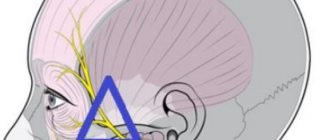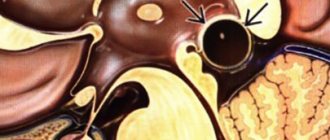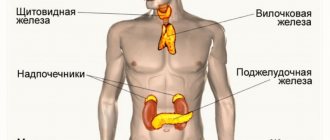Collapse
(lat. collapsus weakened, fallen) - acutely developing vascular insufficiency, characterized primarily by a drop in vascular tone, as well as an acute decrease in the volume of circulating blood. In this case, there is a decrease in the flow of venous blood to the heart, a decrease in cardiac output, a drop in arterial and venous pressure, tissue perfusion and metabolism are disrupted, brain hypoxia occurs, and vital functions of the body are inhibited. Collapse develops as a complication, more often in severe diseases and pathological conditions.
Forms of acute vascular insufficiency are also fainting (see) and shock (see).
The doctrine of Collapse arose in connection with the development of ideas about circulatory failure (see). The clinical picture of Collapse was described long before the introduction of this term. Thus, S.P. Botkin (1883), in a lecture in connection with the death of a patient from typhoid fever, presented a complete picture of infectious Collapse, calling this condition intoxication of the body. I. P. Pavlov (1894) drew attention to the special genesis of Collapse, noting that it is not associated with heart weakness, but depends on a decrease in the volume of circulating blood. The doctrine of Collapse received significant development in the works of G. F. Lang, N. D. Strazhesko, I. R. Petrov, V. A. Negovsky and other domestic scientists.
A generally accepted definition of K. has not been developed. The greatest disagreement exists on the question of whether K. and shock should be considered independent conditions or considered only as different periods of the same pathological process, that is, whether “shock” and “collapse” should be considered synonyms. The last point of view is accepted by the English. and Amer. Authors who believe that both terms denote identical pathological conditions prefer to use the term “shock.” Franz. researchers sometimes contrast K. with inf. shock disease of traumatic origin.
G. F. Lang, I. R. Petrov, V. I. Popov, E. I. Chazov and other domestic authors usually distinguish between the concepts of “shock” and “collapse”. Often these terms are still confused.
Collapse as an indicator of pathological conditions in the body
Vascular collapse usually occurs as a result of a combination of exposure to various factors (pathogenic microorganisms, extremely low or high temperature, etc.) and the initial state of health. In other words, blood stops circulating normally, mainly in the presence of a serious pathology, a long-term chronic disease. The sudden development of collapse against the background of apparent complete well-being is a good reason to undergo a thorough further examination.
Exodus
Death occurs when assistance is not provided in a timely manner. Recovery is possible in some cases. Much depends on the provision of first aid.
First aid can be provided by a paramedic. But it is important to ensure medicinal administration of drugs. This allows you to restore brain function.
The outcome depends on the severity of the disease, as well as on the type of collapse. Cardiogenic collapse is associated with cardiac pathology. Therefore, it is advisable to carry out certain therapeutic therapy. Most often, hypovolemic collapse ends unfavorably.
go to top
Changes in the body that occur during collapse
When the body is exposed to pathological factors, a pathogenetic chain of adverse events develops:
- decreased vascular tone leads to their expansion and an increase in the volume of the vascular bed;
- normal or reduced (due to blood loss, burns, dehydration, etc.) volume of circulating blood as a result of decreased vascular resistance cannot provide all organs and systems with adequate blood supply, and subsequently blood redistribution occurs;
- blood is redistributed unevenly: deposited in the vessels of the abdominal cavity and lungs, it enters the skin, muscle tissue, brain and kidneys in a significantly reduced mass;
- the return of blood to the heart is significantly reduced, so the heart begins to work at a faster pace to provide the body with blood flow;
- slowing down of blood flow in the vessels as a result of deposition and insufficiently efficient work of the heart lead to blood stagnation, the formation of blood clots and even greater circulatory disorders;
- inhibition of blood supply to individual organs leads to the formation of multiple organ failure (cardiovascular, cerebral, respiratory, renal) and the appearance of clinical manifestations of collapse.
In the dictionary Dictionary of foreign words
{not: collapse}, a, m.
1. honey. Sudden onset of vascular insufficiency, accompanied by a drop in arterial and venous blood pressure, hypoxia, which causes a serious condition of the patient.||Cf. COMA" title='COMA, COMA is, what is COMA, COMA interpretation'>COMA I, SHOCK.
2. trans. A severe crisis in the economy and social life of the country, accompanied by a drop in production, the destruction of economic ties, and a decrease in the standard of living of the majority of the population. The country is in a state of collapse.
Share the meaning of the word:
Reasons leading to the development of a collaptoid state
To date, the etiology of collapse has been well studied, which allows us to identify the main causes of its occurrence as a result of exposure to the body:
- infectious agents (causative agents of dysentery, botulism, meningoencephalitis, typhoid fever, influenza, and so on);
- massive blood loss (for example, as a result of injury, bleeding from a gastric or duodenal ulcer, from esophageal varices);
- severe burns;
- severe dehydration;
- toxins, poisons (especially cyanide, carbon monoxide, organophosphorus compounds);
- medications (most often antihypertensive, antiarrhythmic, b-blockers, as well as local anesthetics when released into the general bloodstream);
- various physical factors (too high or too low temperature, electric current, radioactive radiation):
- allergens (in case of development of an anaphylactic reaction);
- a decrease in venous tone, which leads to the development of orthostatic collapse (occurs after prolonged bed rest, a long-term serious illness, certain diseases of the endocrine system, and sometimes occurs in the postoperative period).
Almost everyone has encountered a condition (if not personally, then seen something similar in a film or read in literature) when a person who stood up quickly suddenly falls, “settles,” and becomes weaker. This is the so-called orthostatic collapse, which develops as a result of redistribution of blood flow, an increase in the vascular venous bed (due to decreased tone of the vein walls) and a significant decrease in the return of blood back to the heart.
Photo: https://pixabay.com/photos/medications-money-cure-tablets-257336/
In addition to the listed pathological factors, various acute diseases or chronic diseases in the deteriorating stage play an important role:
- cardiovascular - acute myocardial infarction, pulmonary embolism, severe heart rhythm disturbances (including pacemaker dysfunction), dissecting aortic aneurysm, artificial heart valve dysfunction, acute myocarditis, pericarditis and others;
- severe pneumonia;
- acute pancreatitis and so on.
Forecast
Quick elimination of the cause that caused K. (orthostatic, hypoxemic, reflex, hemorrhagic) often leads to complete restoration of hemodynamics in both adults and children. In severe diseases and acute poisoning, the prognosis often depends on the severity of the underlying disease, the degree of vascular insufficiency, and the age of the patient. If therapy is insufficiently effective, K. may recur. Patients tolerate repeated K. more severely, and they are one of the main causes of death of the underlying disease.
In severe cases, when the underlying disease becomes irreversible and treat. measures turn out to be ineffective, vascular disorders associated with C. progress, irreversible changes in c occur. n. pp., leading to death.
Prevention
such a complication as Collapse consists of intensive treatment of the underlying disease, constant monitoring of patients in severe and moderate condition; in this regard, monitor observation plays a special role (see). It is important to take into account the characteristics of the pharmacodynamics of drugs (ganglionic blockers, neuroleptics, antihypertensive and diuretics, barbiturates, etc.), allergy history and individual sensitivity to certain drugs and nutritional factors. It is necessary to explain to teachers and coaches about the inadmissibility of long-term immobile standing of children and adolescents on lines, training camps, sports formations, etc.
Bibliography:
Akhunbaev I.K. and Frenkel G.L. Essays on shock and collapse, Frunze, 1967, bibliogr.; Dombrovskaya Yu. F. Clinic and pathogenesis of hypoxemia of a growing organism, M., 1961, bibliogr.; Kerpel-Fronius E. Pathology and clinic of water-salt metabolism, trans. from Hungarian, Budapest, 1964; Lang G. F. Diseases of the circulatory system, M., 1938, bibliogr.; Levin Yu. M. Regional blood circulation in terminal conditions, M., 1973, bibliogr.; Luzhnikov E.A., Dagaev V.N. and Firsov N.N. Fundamentals of resuscitation in acute poisoning, M., 1977; Negovsky V. A. Current problems of resuscitation, M., 1971, bibliogr.; Petrov I.R. Shock and collapse, L., 1947, bibliogr.; Petrov I. R. and Vasadze G. Sh. Irreversible changes in shock and blood loss, L., 1972, bibliogr.; Guide to clinical resuscitation, ed. T. M. Darbinyan, p. 9, M., 1974; Smetnev A. S. and Petrova L. I. Emergency conditions in the clinic of internal diseases, M., 1977, bibliogr.; Teodori M.I. Complications that arise during various periods of the course of myocardial infarction, in the book: Grudn. toad and myocardial infarction, ed. A. 3. Chernova, p. 102, M., 1959, bibliogr.; Chazov E.I. Essays on emergency cardiology, M., 1973; Chernukh A. M., Alexandrov P. N. and Alekseev O. V. Microcirculation, M., 1975, bibliogr.; Encyclopedic Dictionary of Military Medicine, vol. 2, art. 1367, M., 1947, bibliogr.; Friedberg C h. K. Diseases of the heart, v. 1-2, Philadelphia - L., 1966; Gersmeyer E.F. u. Yasargil E.C. Schock- und Kollaps-Fibel, Stuttgart, 1970, Bibliogr.; Thal A. ao Shock, Chicago, 1971.
G. K. Alekseev; B.B. Bulychev, B.B. Maleev (inf.), B.M. Balagin, S.I., Denisova-Nikolskaya (ped.).
Classification
Conventionally, the following types of collapse can be distinguished:
- cardiogenic - develops as a result of a decrease in cardiac output (blood volume from the ventricles of the heart), which is observed, for example, with extensive myocardial infarction, heart rhythm disturbances;
- vasodilation – formed with a sharp decrease in vascular tone (vascular resistance), most often as a result of overheating of the body, an overdose of certain medications, or the course of severe infectious processes;
- hypovolemic – occurs when the volume of circulating blood decreases as a result of massive bleeding, repeated vomiting and diarrhea, deep and extensive burns;
- orthostatic.
The main reasons for the progression of the disease under study
If collapse occurs, emergency care is indicated in the following situations:
- acute bleeding, resulting in the loss of a large amount of blood,
- serious burns,
- viral diseases,
- intoxication with certain medications,
- stressful situations; depressive mood
- acute cardiovascular failure,
- diseases in the nervous system,
- endocrine pathology.
Symptoms of collapse
Collapse develops mainly suddenly and is characterized by the occurrence of typical clinical manifestations that accompany a sharp deterioration in a person’s condition. Among them, the most commonly observed are:
- severe general weakness;
- apathy, indifference to what is happening around, lethargy;
- dizziness, flashing “spots”, the appearance of a “veil” before the eyes;
- sweating, chills;
- thirst;
- significant reduction or cessation of urine output;
- rapid breathing and heartbeat, sometimes – interruptions in heart function;
- trembling of fingers, convulsions may occur.
During collapse, a sudden loss of consciousness may occur - fainting (syncope), which usually indicates suppression of blood supply to the brain.
Photo: https://pixabay.com/photos/forest-trees-sky-nature-green-1366345/
There are signs that can be used to predict an unfavorable outcome of collapse in the absence of timely assistance:
- severe headache that occurs suddenly;
- a burning sensation, heaviness behind the sternum, often spreading to the neck and lower jaw on the left, less often to the left arm;
- sharp “dagger” pain in the abdomen;
- a pronounced increase in breathing, while the person experiences suffocation;
- increased heart rate over 160 or decreased to less than 40 beats per minute;
- maintaining a significant decrease in blood pressure even after placing the patient in a horizontal position;
- the presence of known serious diseases in the victim (for example, life-threatening cardiac arrhythmias, aneurysm of the aorta or cerebral artery, chronic ischemic and non-ischemic diseases of the cardiovascular system, peptic ulcer, and so on);
- elderly age.
Features of collapse in children
There are two main causes of K. in children and adolescents: strong emotional disturbances (emotional K.) and prolonged standing motionless or too rapid a transition from a horizontal to a vertical position (orthostatic K.). In children, especially in adolescence, these forms of K. are observed more often than in adults, which is associated with insufficient development of regulatory and compensatory mechanisms of the cardiovascular system, primarily peripheral vessels. Orthostatic and emotional K. is often observed in adolescence and is associated with disproportion of growth, relative immaturity and imperfection of the nervous and hormonal regulation of vascular reactions.
K. in patol conditions (dehydration, starvation, hidden or obvious blood loss, “sequestration” of fluid in the intestines, pleural or abdominal cavities) is more severe than in adults. More often than in adults, K. develops with toxicosis and inf. diseases accompanied by high fever, vomiting, diarrhea. According to E. Kerpel-Froniusz, young children have three times less water per unit of body surface than adults, so their fluid loss occurs faster, leading to pronounced manifestations of dehydration. A decrease in blood pressure and impaired blood flow in the brain occur with deeper tissue hypoxia and are accompanied by loss of consciousness and convulsions. Since in young children the alkaline reserve in the tissues is limited, disruption of oxidative processes during acidosis easily leads to decompensated acidosis. Insufficient concentration and filtration capacity of the kidneys and the rapid accumulation of metabolic products complicate K.'s therapy and delay the restoration of normal vascular reactions.
Diagnostics
K. in young children is difficult due to the fact that it is impossible to find out the patient’s sensations, and systolic blood pressure in children, even under normal conditions, may not exceed 80 mm Hg. Art. The most characteristic for K. in a child can be considered a complex of symptoms: weakening of the sonority of heart sounds, a decrease in pulse waves when measuring blood pressure, general adynamia, weakness, pallor or spotting of the skin, increasing tachycardia.
Therapy for orthostatic and emotional pain, as a rule, does not require medication; It is enough to lay the patient horizontally without a pillow and raise the legs above the level of the heart, unbutton the clothes. Fresh air and inhalation of ammonia vapor have a beneficial effect. Only with deep and persistent K. with a decrease in systolic blood pressure below 70 mm Hg. Art. Intramuscular or intravenous administration of vascular analeptics (caffeine, ephedrine, mezatone) in age-related dosages is indicated. With K. due to blood loss and inf. diseases, the same measures are indicated as in adults, with the prescription of medications in age-specific dosages.
First aid for collapse: a reminder for those nearby
Act quickly and confidently, without wasting time in panic; your help can save the life of the victim.
First aid for collapse includes several simple but very important points.
- It is necessary to place the person on a hard horizontal surface, while raising the lower limbs (so that the legs and the surface are about 45 degrees).
- Try to stop bleeding if it exists, as well as stop exposure to other unfavorable factors, such as high fever.
- Open the windows to provide fresh air into the room.
- Unfasten belts, buttons, fasteners while keeping clothes tightly attached to the chest and stomach.
- Let the vapor of ammonia soaked in cotton wool or gauze be inhaled through your nose (hold it near your nose for no more than a second).
- If you have a chill, cover with a warm blanket or blanket (this especially applies to the lower extremities).
- Check the patency of the upper respiratory tract: examine the oral cavity for the presence of dentures, foreign objects, food (in order to avoid suffocation due to their entry into the larynx, trachea and bronchi).
- If a person is unconscious or vomiting, experts advise turning the victim on his side, securing this position with a roll of clothing or a blanket.
- If you have a tonometer, measure your blood pressure and count your pulse per minute.
- Call an ambulance, telling in detail about the person’s condition, describing the circumstances of the development of collapse (sudden deterioration in condition, symptoms that preceded it, previously taken medications, the presence of any diseases or pathological conditions, if known).
The appearance of the patient during collapse is of great importance (when seeking medical help, he should be presented in detail to the ambulance dispatcher): pallor of the skin, sometimes with bluish lips and fingers and toes, while the skin is cold, wet and sticky to the touch, dilation of the pupils is often observed, blood pressure is reduced or not determined, the pulse is often accelerated or very rare, weak (thread-like), and frequent shallow breathing is observed.
- Prepare medications taken by the patient, as well as the patient’s epicrisis from the outpatient card/medical history, electrocardiogram, prescriptions, and so on (this way, medical workers will have a better understanding of the patient’s medical history, which will allow them to quickly determine the cause of the collapse).
- Stay with the injured person until the ambulance arrives.
You should not administer any medications or perform medical procedures on your own without the necessary education! However, this statement does not apply to a situation where there is no breathing or heartbeat: any person must have the skills of cardiopulmonary resuscitation and provide it if necessary.
Photo: https://pixabay.com/photos/ambulance-medicine-hospital-1005433/
Clinical picture
The clinical picture for K. of various origins is basically similar. K. develops more often acutely, suddenly.
In all forms of K., the patient’s consciousness is preserved, but he is indifferent to his surroundings, often complaining of a feeling of melancholy and depression, dizziness, blurred vision, tinnitus, and thirst. The skin turns pale, the mucous membrane of the lips, the tip of the nose, fingers and toes acquire a cyanotic tint. Tissue turgor decreases, the skin may become marbled, the face is sallow in color, covered with cold sticky sweat, the tongue is dry. Body temperature is often low, patients complain of cold and chilliness. Breathing is shallow, rapid, less often slow. Despite shortness of breath, patients do not experience suffocation. The pulse is small, soft, rapid, less often slow, weak filling, often irregular, and is sometimes difficult to detect or absent on the radial arteries. Blood pressure is reduced, sometimes systolic blood pressure drops to 70-60 mm Hg. Art. and even lower, but in the initial period of K. in persons with previous hypertension, blood pressure may remain at a level close to normal. Diastolic pressure also decreases. Superficial veins collapse, blood flow speed, peripheral and central venous pressure decrease. In the presence of heart failure of the right ventricular type, central venous pressure may remain at normal levels or decrease slightly; the volume of circulating blood decreases. On the part of the heart, there is dullness of tones, arrhythmia (extrasystole, atrial fibrillation, etc.), embryocardia.
The ECG shows signs of coronary blood flow insufficiency and other changes that are secondary in nature and are most often caused by a decrease in venous inflow and the associated disturbance of central hemodynamics, and sometimes by infectious-toxic damage to the myocardium (see Myocardial dystrophy). Impaired cardiac contractility can lead to a further decrease in cardiac output and progressive hemodynamic impairment. Oliguria, nausea and vomiting (after drinking), azotemia, blood thickening, increased oxygen content in venous blood due to shunting of blood flow, and metabolic acidosis are almost always observed.
The severity of K.'s manifestations depends on the severity of the underlying disease and the degree of vascular disorders. Also important is the degree of adaptation (for example, to hypoxia), age (in older people and young children, K. is more severe) and the emotional characteristics of the patient, etc. A relatively mild degree of K. is sometimes called a collaptoid state.
Depending on the underlying disease that caused K., the wedge, the picture may acquire some specific features. So, for example, with K., which occurs as a result of blood loss, instead of depression of the neuropsychic sphere, excitement is often observed at first, and sweating often sharply decreases. K.'s phenomena in toxic lesions, peritonitis, acute pancreatitis are most often combined with signs of general severe intoxication. Orthostatic K. is characterized by suddenness (often against the background of good health) and a relatively mild course; Moreover, to relieve orthostatic K., especially in adolescents and young men, it is usually sufficient to ensure rest (in a strictly horizontal position of the patient), warming and inhalation of ammonia.
Infectious Collapse develops more often during a critical decrease in body temperature; this occurs at different times, for example, with typhus, usually on the 12-14th day of illness, especially during an abrupt decrease in temperature (by 2-4°), often in the morning. The patient becomes very weak, lies motionless, apathetic, answers questions slowly and quietly; complains of chills and thirst. The face becomes pale earthy in color, the lips are bluish; facial features become sharper, eyes are sunken, pupils are dilated, limbs are cold, muscles are relaxed. After a sharp drop in body temperature, the forehead, temples, and sometimes the whole body are covered with cold, sticky sweat. Body temperature when measured in the armpit sometimes drops to 35°; the gradient of rectal and skin temperature increases. The pulse is frequent and weak. Blood pressure and diuresis are reduced.
Current inf. K. is aggravated by dehydration (see), hypoxia (see), the edges are complicated by pulmonary hypertension, decompensated metabolic acidosis, respiratory alkalosis and hypokalemia. When a large amount of water is lost through vomit and feces due to food toxic infections, salmonellosis, acute dysentery, cholera, the volume of extracellular, including interstitial and intravascular, fluid decreases. The blood thickens, its viscosity, density, hematocrit index, and total plasma protein content increase. The volume of circulating blood decreases sharply. Venous inflow and cardiac output are reduced. According to biomicroscopy of the conjunctiva of the eye, the number of functioning capillaries decreases, arteriovenular anastomoses, pendular blood flow and stasis occur in venules and capillaries with a diameter of less than 25 microns
With signs of aggregation of blood cells. The ratio of the diameters of arterioles and venules is 1: 5 (the norm is 1: 2.5). With inf. diseases K. lasts from several minutes to 6 - 8 hours. (usually 2-3 hours).
As K. deepens, the pulse becomes thread-like; It is almost impossible to determine blood pressure; breathing becomes more frequent. The patient's consciousness gradually darkens, the reaction of the pupils is sluggish, tremor of the hands is observed, and convulsions of the muscles of the face and arms are possible. Sometimes K.'s phenomena increase very quickly; facial features sharpen sharply, consciousness darkens, pupils dilate, reflexes disappear, and with increasing weakening of cardiac activity, agony occurs (see).
Death with K. occurs due to depletion of the energy resources of the brain as a result of tissue hypoxia, intoxication, and metabolic disorders.
Diagnosis of the causes of collapse
In order to choose the right tactics for eliminating the collaptoid state, it is necessary to find out the cause of the development of the pathological condition.
For this we use:
- a thorough examination of the patient (presence of injuries, burns, active bleeding, condition of the skin, measurement of blood pressure, counting pulse and respiratory rate, assessment of heart rhythm, and so on);
- during a general examination, complaints are clarified, as well as an anamnesis of life and illness, the circumstances under which the condition worsened;
- general blood test (signs of bleeding, dehydration, infectious process, etc.);
- biochemical blood test (sugar level, kidney, liver, etc.);
- coagulogram (signs of activation or inhibition of the blood coagulation system);
- registration of an electrocardiogram (pay attention to the presence of blockades, serious heart rhythm disturbances, ischemic changes, as well as specific changes characteristic of other pathological conditions, for example, pulmonary embolism);
- according to indications, it is possible to conduct a more in-depth study: ECHO-CG, HM-ECG, EEG, FGDS, FCS, CT, MRI, X-ray and so on.
Doctors of various specialties are often invited to consultations, for example, a neurologist, cardiologist, arrhythmologist and others, if necessary.
Treatment
With the development of K., intensive therapy is always necessary, aimed at eliminating the cause that caused K. or at weakening its effect. Indispensable conditions for the effectiveness of therapy are its immediate initiation, ensuring rest and warming the patient. The most important is etiological therapy: for such treatment. Measures depending on the cause of K. include stopping bleeding (see), removal of toxic substances from the body (see Detoxification therapy), specific antidote therapy, elimination of hypoxia, giving the patient a strictly horizontal position during orthostatic K., immediate administration of adrenaline, desensitizing agents (see) for anaphylactic K., elimination of cardiac arrhythmia, etc.
The main goal of pathogenetic therapy is to stimulate blood circulation and respiration, and increase blood pressure. An increase in venous flow to the heart is achieved by transfusion of blood-substituting fluids (see), blood plasma and other liquids, as well as by means affecting peripheral circulation. Therapy for dehydration and intoxication is carried out by administering polyionic pyrogen-free crystalloid solutions (acesol, disol, chlosol, lactasol). The infusion volume for emergency treatment is 60 ml of crystalloid solution per 1 kg of body weight. Infusion rate 1 ml/kg per 1 min. Infusion of colloidal blood substitutes in severely dehydrated patients is contraindicated. With hemorrhagic K, blood transfusions are of paramount importance; In order to restore the volume of circulating blood, massive intravenous administration of blood substitutes (polyglucin, reopolyglucin, hemodez, etc.) or blood is carried out by stream or drip. Reopoliglucin has a beneficial effect on microcirculation), hemodez (a solution of low molecular weight polyvinylpyrrolidone) has a predominant detoxification effect. Transfusions of native and dry plasma, conc., are also effective in restoring circulating blood volume. solution of albumin and protein. Infusions of isotopic saline solutions or glucose solutions are less reliable. The amount of infusion solution is determined by the wedge, indicators, blood pressure level, diuresis state and, if possible, controlled by determining hematocrit, circulating blood volume and central venous pressure. The introduction of drugs that excite the vasomotor center (cordiamin, caffeine, camphor, etc.) is also aimed at eliminating hypotension.
Vasopressor drugs (norepinephrine, mesaton, angiotensin, adrenaline, etc.) are indicated for severe toxic, orthostatic, reflex K. For hemorrhagic K., it is advisable to use them only after restoration of blood volume, and not for the so-called. empty riverbed. If blood pressure does not increase in response to the administration of sympathomimetic amines, one should think about the presence of severe peripheral vasoconstriction and high peripheral resistance; in these cases, further use of sympathomimetic amines can only worsen the patient's condition. Therefore, vasopressor therapy should be used cautiously. The effectiveness of α-blockers to eliminate peripheral vasoconstriction has not yet been sufficiently studied.
In the treatment of K., not associated with ulcer bleeding, glucocorticoids are effective, used for a short time in sufficient doses (hydrocortisone, sometimes up to 1000 mg or more, prednisolone from 90 to 150 mg, sometimes up to 600 mg intravenously or intramuscularly).
To eliminate metabolic acidosis, along with agents that improve hemodynamics, 5-8% sodium bicarbonate solution is used in an amount of 100-300 ml intravenously or lactasol solution. When K. is combined with heart failure, the use of cardiac glycosides and active treatment of acute disorders of heart rhythm and conduction become essential.
Oxygen therapy is especially indicated for K. resulting from carbon monoxide poisoning or against the background of an anaerobic infection; in these forms, the use of oxygen under high pressure is preferable (see Hyperbaric oxygenation). In case of protracted course of K., when the development of multiple intravascular coagulation (consumptive coagulopathy) is possible, as a treatment. agents use heparin intravenously, up to 5000 units every 4 hours (exclude the possibility of internal bleeding!).
If K. developed against the background of severe inf. illness, the patient is warmed by carefully covering them with heating pads, legs should be elevated. The body and limbs can be rubbed with camphor or diluted ethyl alcohol. Specific drug therapy is carried out depending on the underlying infectious disease.
For detoxification and restoration of circulating blood volume during inf. K. infusion of colloidal blood substitutes is sometimes used.
For all types of K., careful monitoring of respiratory function is necessary, and, if possible, with the study of gas exchange parameters. When respiratory failure develops, auxiliary ventilation is used (see Artificial respiration).
Resuscitation care for K. is provided according to the general rules (see Resuscitation). According to E. A. Luzhnikov (1977), to maintain an adequate minute volume of blood during external cardiac massage in conditions of hypovolemia, the frequency of cardiac compressions should be increased to 100 per minute.
Therapeutic measures
The reason for the development of collapse is determined by the algorithm for providing assistance:
- when exposed to poisons, toxins, drugs - remove substances from the body as quickly and completely as possible, use specific antidotes;
- stopping bleeding, replenishing blood loss with blood components or blood substitutes;
- stopping the use of the drug that caused anaphylactic shock, anti-shock measures (infusion therapy, antihistamines, adrenergic agonists, glucocorticosteroids, etc.);
- the use of antiarrhythmic drugs, electrical pulse therapy, temporary or implantable pacemakers for cardiac arrhythmias;
- the use of cardiotropic treatment for acute myocardial infarction, myocarditis, pericarditis, cardiomyopathies and other diseases of the cardiovascular system;
- the use of antiviral and/or antibacterial drugs in the presence of an infectious process, and so on (depending on the etiological factor).
Photo: https://pixabay.com/photos/medicine-pills-blood-pressure-2994788/
Emergency care for collapse of almost any etiology includes the use of:
- inhalation of humidified oxygen;
- infusion therapy;
- glucocorticosteroids;
- vasopressor drugs.
These measures are used after performing the first aid described above. The patient is usually hospitalized in the intensive care unit (or in a specialized hospital), where treatment and monitoring of hemodynamic parameters continue.
Pathological changes
Pathoanatomical changes in K. have not been studied enough; most often they are determined by the underlying disease, in which Krom occurs. Morphol, changes characteristic of organ ischemia are often noted (see Ischemia). Among the specific morphological signs of hemorrhagic K., distinguishing it from traumatic shock, I. V. Davydovsky includes blood thinning, a decrease in hemoglobin content, pallor, dry tissue with a decrease in the content of lymph in them, a decrease in the weight of organs, and the absence of pulmonary edema.
The danger of a collapsed state
When collapse develops, it is important to remember that the further prognosis depends on how quickly the correct emergency care is provided. You need to understand that minutes of delay can cost the victim his life. In the absence of adequate medical care, collapse quickly leads to multiple organ failure and disruption of the normal functioning of internal organs.
The greatest danger is the developing disruption of the blood supply to the brain, which can lead to ischemia and massive death of nerve cells.
In adults
Collapse in adults is quite severe. In this case, there is a condition that requires urgent medical attention. The most common causes of this condition in adults are:
- period of intoxication;
- infections (chronic);
- cardiac pathology;
- massive blood loss;
- severe stress
At any age, a person can be overcome by extreme stress. And this process is pathological. In this case, the cerebral cortex suffers. Brain hypoxia occurs.
In adults, cardiogenic collapse may occur. As a consequence of heart disease. Typically, this pathology occurs more often in males. Women are also susceptible, but less so.
Intoxication can cause collapse. Alcohol intoxication may usually be present. Drug poisoning. Excessive alcohol consumption leads to various vascular disorders.
Massive blood loss is an unexpected condition. May require urgent medical attention. Hospitalization is mandatory.
go to top
Other factors
There is compelling evidence supporting attenuation of the baroreflex response as a mechanism responsible for ON and FCI. It is noted that heat stress may promote this response. However, several other factors have been studied that could also aggravate the reaction.
A weakening of the sensitivity of the baroreflex during hypoglycemia was found. This is important because serum glucose levels decrease with increasing exercise duration, which may increase the susceptibility of endurance and ultra-endurance athletes to CPT (36). Striving for a target time or a high pace is also associated with CF (30). When trying to achieve a final or temporary goal, the breathing rate increases, as a result, the athletes' carbon dioxide concentration decreases. Studies show a protective effect of hypercapnia (37) and the resulting hypocapnia further impairs the baroreflex (38).
Taking medications may influence the response to LBCI: taking antidepressants is a possible factor in CFN because it significantly impairs the reflex cardiovascular response to exercise by altering neurochemical reactions (39). In addition, in two independent randomized controlled clinical trials, H1 and H2 receptor antagonists blunted post-exercise hypotension, suggesting that histamine may also play a role in CEF (40, 41) (Table 4).
Table 4. Other factors
| Source | Author/journal | Year | Type of study | Patients | results | UD |
| 36 | Adler et al Diabetes | 2009 | Clinical trial | 20 men | Previous hypoglycemia impairs baroreflex sensitivity and hypotensive stress response | 2 |
| 37 | Howden et al Exp Physiol | 2004 | Case-control | 9 subjects | Increased arterial CO2 is associated with increased cerebral blood flow | 3 |
| 38 | Lucas et al J Appl Physiol | 2008 | Cross | 9 men | Postural hypotension and hypocapnia exacerbate cerebral hypoperfusion during prolonged exercise | 3 |
| 39 | Middleton et al Eur J Clin Pharmacol | 1987 | Case-control | 7 women and 7 control group | Significant impairment of the cardiovascular reflex response when taking antidepressants | 3 |
| 40 | Lockwood et al J Physiol | 2005 | Randomized controlled trial | 14 healthy men and women | H1 receptor antagonists reduce post-exercise vasodilation and blunt post-exercise hypotension | 1 |
| 41 | McCord et al J Appl Physiol | 2006 | Randomized controlled trial | 10 healthy men and women | H2 receptor antagonists reduce post-exercise vasodilation and blunt post-exercise hypotension | 1 |
| LE - level of evidence | ||||||
conclusions
FCI is a common phenomenon in endurance activities, which is characterized by collapse after completion of competition without neurological, biochemical or thermal abnormalities. CFN is perhaps the most common etiology for medical providers serving competitions in the field. But the doctor needs to remember that KFN is diagnosed after excluding other etiologies that cause collapse. There is no scientific evidence to support previous assumptions that dehydration or heat stress is the cause of CFI. However, these factors, along with medications, hypocapnia and hypoglycemia, contribute to CFI. According to the modern point of view, the cause of postural hypotension is blood retention in the lower extremities due to a decrease in peripheral resistance in conditions of a weakened baroreflex response, which causes CFP. In women, KFN is predominantly not due to a violation of the baroreflex, but due to a decrease in cardiac filling. Treatment of CFP is usually symptomatic and includes oral fluid intake and the Trendelenburg position. General body cooling, intravenous hydration, or advanced treatments are not usually needed.
Rice. 1. Algorithm for collapse of physical activity.
T, temp. - temperature; SBP – systolic blood pressure; HR – heart rate, fr – saline solution.
Original
:










